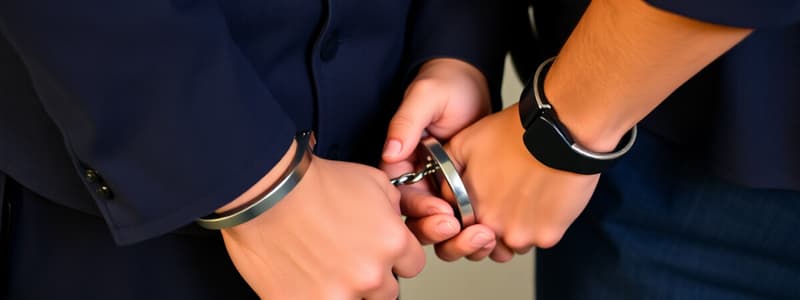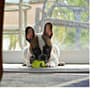Podcast
Questions and Answers
What is an important consideration when choosing a cutting instrument to remove flexible cuffs?
What is an important consideration when choosing a cutting instrument to remove flexible cuffs?
- It should have a sharp pointed end to ensure efficiency.
- It should be made of stainless steel for durability.
- It should be a specialized cuff removal tool only.
- It should not have sharp pointed ends or an exposed blade. (correct)
Which step is NOT part of applying flexible leg restraints?
Which step is NOT part of applying flexible leg restraints?
- Tighten the restraint device to restrict leg movement.
- Control the subject's upper body with a three-point pin.
- Slide the restraints over the upper half of the subject’s legs. (correct)
- Kneel or squat near the subject’s legs.
What is the key reason for ensuring normal blood flow when tightening flexible leg restraints?
What is the key reason for ensuring normal blood flow when tightening flexible leg restraints?
- To prepare for a potential legal review of the restraint methods.
- To maintain a professional appearance while restraining.
- To avoid causing injuries or complications. (correct)
- To ensure the subject remains calm during restraint.
What should be done with the excess portion of the restraint to further limit a subject's movement?
What should be done with the excess portion of the restraint to further limit a subject's movement?
During the application of flexible leg restraints, what position should the subject be in for optimal control?
During the application of flexible leg restraints, what position should the subject be in for optimal control?
What is the first step in applying handcuffs?
What is the first step in applying handcuffs?
What should be done if a weapon has been drawn before approaching the subject?
What should be done if a weapon has been drawn before approaching the subject?
When should the handcuffs be double locked during the handcuffing process?
When should the handcuffs be double locked during the handcuffing process?
What is the last step to take when removing handcuffs?
What is the last step to take when removing handcuffs?
Which position can handcuffs be applied from?
Which position can handcuffs be applied from?
What should be done before removing the handcuffs?
What should be done before removing the handcuffs?
What verbal technique should be used throughout both the application and removal of handcuffs?
What verbal technique should be used throughout both the application and removal of handcuffs?
What is the primary purpose of using restraint devices such as handcuffs?
What is the primary purpose of using restraint devices such as handcuffs?
What is the purpose of waist chains in the context of restraint?
What is the purpose of waist chains in the context of restraint?
Why is continuous monitoring of a subject necessary once handcuffs are applied?
Why is continuous monitoring of a subject necessary once handcuffs are applied?
Which of the following statements best describes the correct handcuffing technique?
Which of the following statements best describes the correct handcuffing technique?
What is the role of the three-point pin in controlling a subject during handcuffing?
What is the role of the three-point pin in controlling a subject during handcuffing?
During the application of a three-point pin, where should the officer's right knee be positioned?
During the application of a three-point pin, where should the officer's right knee be positioned?
Maintaining a bent wrist on the subject’s right arm during restraint serves which purpose?
Maintaining a bent wrist on the subject’s right arm during restraint serves which purpose?
What is the main reason for remaining on the balls of your feet during the three-point pin maneuver?
What is the main reason for remaining on the balls of your feet during the three-point pin maneuver?
How should handcuffs and other restraint devices be maintained?
How should handcuffs and other restraint devices be maintained?
What is the correct distance for the subject's hands from their body when applying handcuffs?
What is the correct distance for the subject's hands from their body when applying handcuffs?
What should be done first when applying leg restraints?
What should be done first when applying leg restraints?
How should the leg restraints be positioned when applying them?
How should the leg restraints be positioned when applying them?
What is the purpose of using flexible leg restraints?
What is the purpose of using flexible leg restraints?
What should be done after tightening the flexible cuff around a subject's wrist?
What should be done after tightening the flexible cuff around a subject's wrist?
What must be done with the chain when applying waist restraints to a subject?
What must be done with the chain when applying waist restraints to a subject?
Why is it typically best to apply flexible leg restraints with more than one officer?
Why is it typically best to apply flexible leg restraints with more than one officer?
What is the correct process for applying flexible cuffs to a subject’s wrists?
What is the correct process for applying flexible cuffs to a subject’s wrists?
Flashcards
Handcuffs
Handcuffs
Temporary restraint device used to control a subject.
Restraint Devices
Restraint Devices
Tools used to temporarily restrict a subject's movement.
Three-Point Pin
Three-Point Pin
Technique to control a subject for handcuffing, using the subject's shoulder and wrist.
Controlled Manner (Handcuffing)
Controlled Manner (Handcuffing)
Signup and view all the flashcards
Reactionary Gap/Danger Zone
Reactionary Gap/Danger Zone
Signup and view all the flashcards
Verbal Commands
Verbal Commands
Signup and view all the flashcards
Subject Monitoring (Handcuffed)
Subject Monitoring (Handcuffed)
Signup and view all the flashcards
Maintaining Control (Right Arm)
Maintaining Control (Right Arm)
Signup and view all the flashcards
Handcuffing Technique Steps
Handcuffing Technique Steps
Signup and view all the flashcards
Removing Handcuffs
Removing Handcuffs
Signup and view all the flashcards
Waist Chains
Waist Chains
Signup and view all the flashcards
Verbal Commands (Restraint)
Verbal Commands (Restraint)
Signup and view all the flashcards
Subject Positioning (Handcuffing)
Subject Positioning (Handcuffing)
Signup and view all the flashcards
Handcuff Application Positions
Handcuff Application Positions
Signup and view all the flashcards
Proper Handcuff Fit
Proper Handcuff Fit
Signup and view all the flashcards
Double Locking Handcuffs
Double Locking Handcuffs
Signup and view all the flashcards
Waist Chain Application
Waist Chain Application
Signup and view all the flashcards
Leg Restraint Application
Leg Restraint Application
Signup and view all the flashcards
Flexible Cuffs
Flexible Cuffs
Signup and view all the flashcards
Double Locking Handcuffs
Double Locking Handcuffs
Signup and view all the flashcards
Proper Cuff Fit
Proper Cuff Fit
Signup and view all the flashcards
Verbal Commands (Restraint)
Verbal Commands (Restraint)
Signup and view all the flashcards
Subject Positioning (Waist Chain)
Subject Positioning (Waist Chain)
Signup and view all the flashcards
Flexible Leg Restraints (Hobbles)
Flexible Leg Restraints (Hobbles)
Signup and view all the flashcards
Removing Flexible Cuffs
Removing Flexible Cuffs
Signup and view all the flashcards
Flexible Leg Restraints
Flexible Leg Restraints
Signup and view all the flashcards
Leg Restraint Application
Leg Restraint Application
Signup and view all the flashcards
Leg Restraint Tightening
Leg Restraint Tightening
Signup and view all the flashcards
Restraint Device Excess
Restraint Device Excess
Signup and view all the flashcards
Study Notes
Restraint Devices
- Restraint devices temporarily restrict a subject's movement.
- Handcuffs, waist chains, leg restraints, and flexible leg restraints are examples.
- Handcuffs frequently used to control a subject.
- Handcuffs do not render a subject harmless.
- Continuous monitoring is necessary to ensure officer safety.
- Applying handcuffs places the officer in a danger zone.
- Handcuffing must be done in a controlled manner.
Handcuffs
- Identify the parts of handcuffs using illustrations (e.g., Figure 4-24).
- Ensure handcuff function by proper maintenance.
- The procedure should minimize potential harm to officers and subjects.
- Subjects may resist after initial application.
- Proper response actions are crucial.
Three-Point Pin
- Used to control subjects for handcuffing.
- The method involves mechanical or pain compliance using parts of the body like the shoulder and wrist.
- Loud, clear verbal commands are crucial throughout the technique.
- Maintain control of the subject's right arm after grounding.
- Control the subject's bent right wrist for compliance.
- Place the knee across the subject's shoulder and avoid pressure to the spinal cord and neck.
- Position the left knee on the ground near the subject's rib area, ensuring the upper arm is in front of the thigh.
- Maintain a standing position while conducting the pin.
Handcuffing Technique
- Technique varies based on subject compliance.
- Use loud, clear verbal commands.
- Inspect subject position for proper handcuffing setup.
- Properly manage weapons before approaching.
- Place cuffs on one wrist then the other.
- Ensure proper fit and double lock the handcuffs.
- Search the subject.
- Several positions are possible: kneeling, standing (front or rear), or prone.
- For non-compliant subjects, use controlling techniques.
Removing Handcuffs
- Use loud, clear verbal commands for the removal process.
- Prepare the subject for removal.
- Draw the handcuff key.
- Remove each cuff, ensuring the cuffs are closed after removal.
- Control the subject's uncuffed hand for safety.
- Move away from the subject after removal.
Waist Chains
- Designed to secure subjects during movement.
- Subject must be in a controlled position.
- Position the subject with hands in front and palms facing each other.
- Place the cuffs on the wrists, ensuring a proper fit and secure double lock.
- The black box is attached to the cuffs.
- The chain is attached to the black box.
- The subject turns and the chain is wrapped around them.
- A padlock is used to further secure the chain.
Leg Restraints
- Used with waist chains for a secure position.
- Subject must be in a controlled position.
- Hold the restraints with the bar facing the subject's legs.
- Ensure the key holes face downwards.
- Subject should be in a balanced stance.
- Apply leg restraints to each ankle, ensure proper fit and a secure double lock.
Flexible Restraints
- Flexible cuffs and flexible leg restraints are used in various situations.
- These restraints are used for multiple arrests and transporting subjects.
- Use care when using or removing flexible handcuffs, ensuring proper technique.
- Applying and removing flexible leg restraints involve placing and tightening the restraints over the lower half of the subject's legs.
- Further securing measures may include restricting movement by bending and positioning the subject.
Studying That Suits You
Use AI to generate personalized quizzes and flashcards to suit your learning preferences.
Related Documents
Description
This quiz covers the fundamentals of restraint devices, particularly focusing on handcuffs and their proper usage in law enforcement. It includes identification of handcuff parts, maintenance, and techniques for safely applying restraints while ensuring officer safety. Understand the importance of controlled procedures and clear communication during the handcuffing process.



